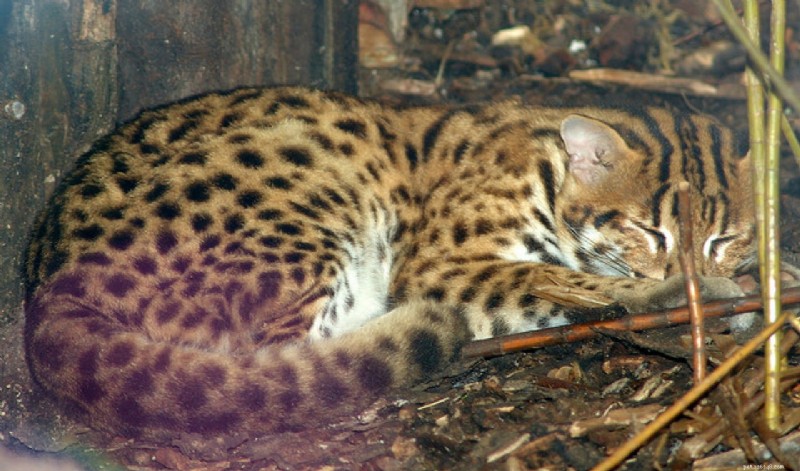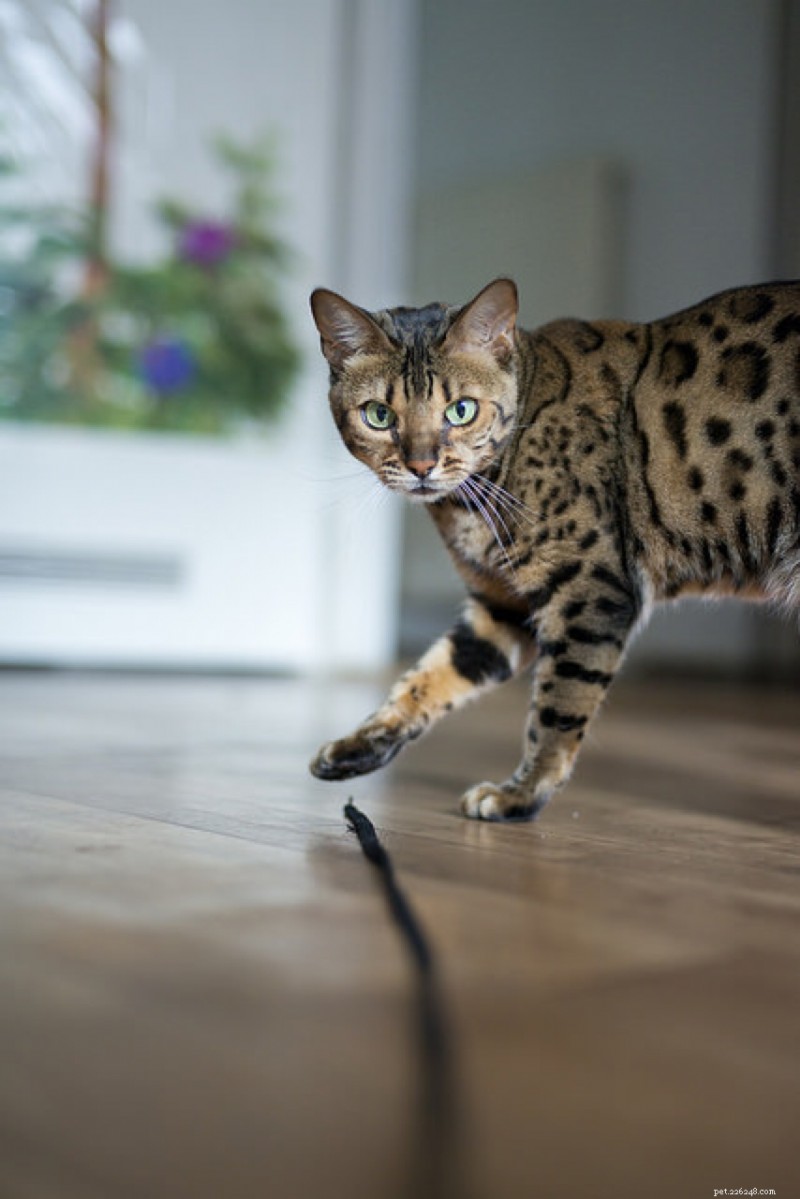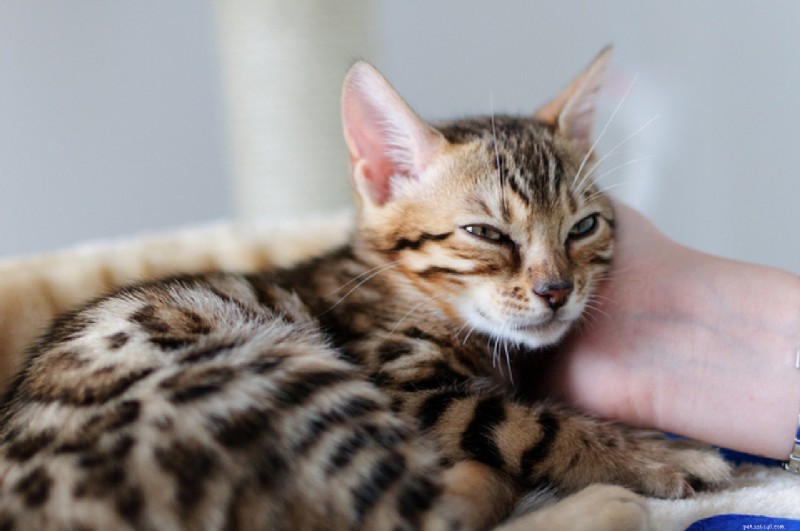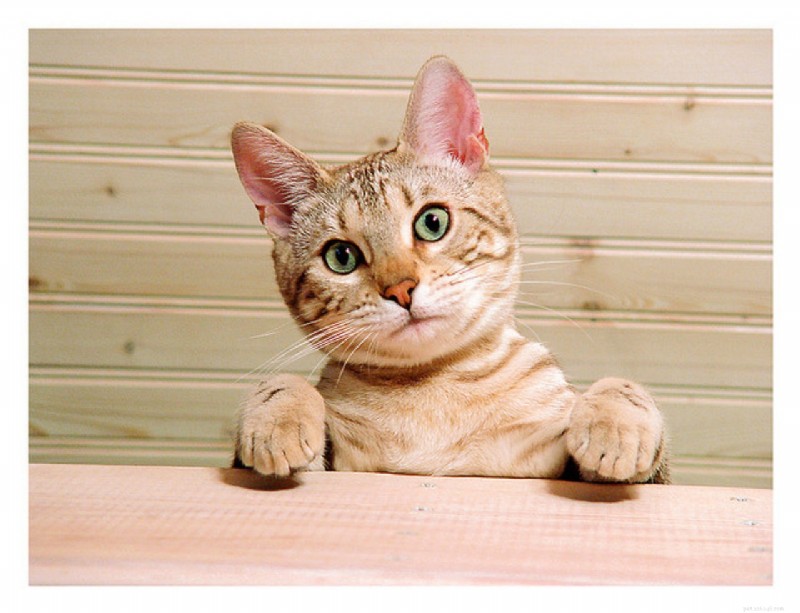
Dit prachtige hybride kattenras kan zijn DNA herleiden tot echte wilde katachtigen, namelijk de Aziatische luipaardkat. Het wordt de Bengaalse kat genoemd vanwege de Latijnse naam van zijn wilde nageslacht - Prionailurus bengalensis - hoewel het bereik van de Aziatische luipaardkat verder reikt dan de kleine Bengaalse regio. Kattenliefhebbers en wetenschappers zijn gefascineerd door het maken van hybriden sinds het einde van de 19e eeuw, toen kattenshows begonnen op te stijgen. Gedurende de jaren '30 en '40 werden verschillende pogingen geregistreerd om de moderne Bengaalse kat te creëren, met teleurstellende resultaten.
Pas in 1963 werd de eerste Bengaalse kat geboren uit Jean S. Mill, het product van haar mannelijke huiskat en een "luipaardkat" die ze in een dierenwinkel kocht. Kin Kin, zoals ze werd genoemd, tartte de verwachtingen van wetenschappers en ging door met het produceren van een tweede generatie Bengalen. De hybridisatie van katten nam een vlucht in de jaren zeventig, vooral na de ontdekking van de natuurlijke immuniteit van sommige wilde katten tegen ziekten zoals FIV en FeLV. Jean S. Mill richtte zich in 1980 opnieuw op Bengaalse katten en kocht er een aantal om te kruisen met een luipaardachtige straatkat die ze in India vond.
De Bengaalse kat werd in 1986 door de International Cat Association (TICA) geaccepteerd als een nieuw kattenras en kreeg in 1991 de status van kampioenschap. De Bengalen van vandaag zijn de vijfde generatie sinds de oorspronkelijke katten van Jean S. Mill, ver verwijderd van hun wilde wortels.
Bengalen kattenpersoonlijkheid en temperament

Hoewel het belangrijk is om te onthouden dat elke kat zijn eigen individuele persoonlijkheid heeft, zijn er enkele eigenschappen die de meeste Bengalen over het algemeen hebben. Het ras staat bekend om zijn uniekheid en wordt vaak omschreven als intelligent, leergierig en interactief. Van Bengalen is bekend dat ze basisspellen spelen zoals apporteren of verstoppertje, genieten van speeltijd en algemeen kattenkwaad. Die zwemmende kattenvideo's bevatten grotendeels Bengaalse katten, 'kattenpeddelende' baantjes in een badkuip.
Gehechtheid aan mensen is ook een belangrijk onderdeel van de Bengaalse persoonlijkheid. Als je op zoek bent naar een constante metgezel, nieuwsgierig in alles wat je doet, dan is dit het juiste ras voor jou! “Bengalen zullen over het algemeen ook ALTIJD willen zijn waar je bent. Daar zit tenslotte de actie!” adviseert TICA. “And Bengals are all about ‘the action.'” Channel their high energy into mental stimulation, with puzzle toys, supervised outdoor visits or a catio, a birdhouse (to watch), or general hunt-based play with toys.
Bengal Breeders or Rescue?
Most pet parents looking for a specific breed of cat go straight to a breeder for their new fur baby. However, there are always breed-specific rescues that have plenty of felines who need furever homes. A quick Internet search for “Bengal rescue” shows organizations across the country (and world) dedicated to rehoming Bengal cats. Many Bengal rescues are regional, so even if the group isn’t based in your state, give them a call! If they can’t help you, ask if they know anyone in your area who can; the Bengal Rescue Network has affiliates in every corner of the country and even Canada.

However, if you do decide to go to a Bengal breeder, it’s important to ensure he or she is reputable and will provide you with a healthy pet. Besides your initial search, nothing should be conducted on the Internet! Always visit the breeder’s facilities and meet your pet-to-be in person before making any financial commitments. Ask to see other animals as well, and find out the daily routine – How much playtime do they get? When are they fed? Where do they sleep? For your future pet in particular, ask in-depth questions about personality, quirks, health, and even favorite toys or siblings. If a breeder is loving and professional, they should know the cat like their own pet – after all, they bring these “fur babies” into the world! Be wary of any breeders who want to ship an animal to you or will not provide you with a vet’s clean bill of health. Asking to meet you in a place besides your home or their facilities – say, a grocery store or parking lot – is also a red flag.
Marbled, Glitter, Silver and Snow Bengal Cats

While these may sound like items in a toddler’s craft kit, they’re actually Bengal coat colors and patterns! Most Bengals are varying shades of brown, according to Bengals Illustrated, the breed’s most popular magazine. “No matter what the color/tone, the pattern on a Bengal cat should yield a high degree of contrast,” the publication says. All-black Bengals, often called “pantherettes,” are unrecognized by the TICA for competition status, although many unaffiliated groups celebrate them. Long-haired Bengals have also been reported but are uncommon, the result of a recessive gene.
A marbled Bengal cat has more splotches and swirls than leopard-like spots, which can be reminiscent of a boa snake. The breed’s fur is noted for its excessive sheen, which often seems to glitter in direct light; flecks of gold or silver on the shaft of individual hairs gives the Bengal cat its shine. Sometimes mistaken for Egyptian Maus – whose facial structure, markings and body shape are much different – the silver Bengal is a relatively newcomer to the breed; true silvers have no yellow undertones, and pewter to black spots.
Although generally referred to as the white or snow Bengal cat, there are technically several patterns with a white base coat. Seal Lynx Points, Seal Minks, and Seal Sepias show a spectrum of contrasting colors – all have a coat color described as “creamy” white, not pure. Snow Bengals can have gorgeous green, blue or copper eyes, and coat patterns often develop as a kitten ages.
(Featured image via Wikimedia Commons)